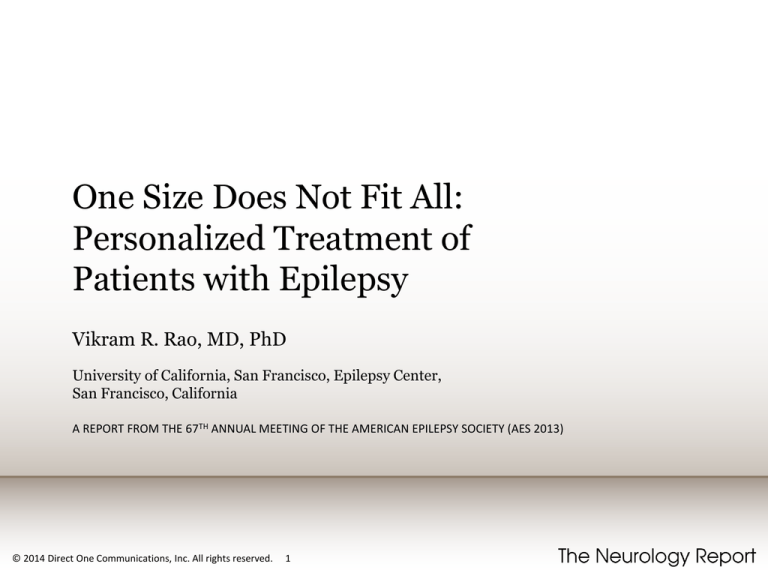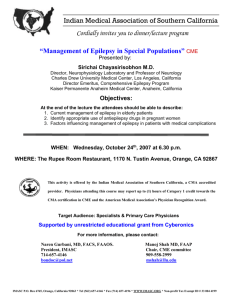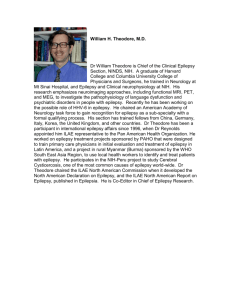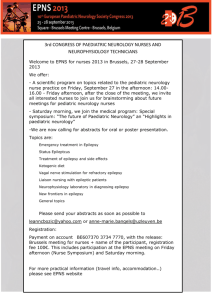
One Size Does Not Fit All:
Personalized Treatment of
Patients with Epilepsy
Vikram R. Rao, MD, PhD
University of California, San Francisco, Epilepsy Center,
San Francisco, California
A REPORT FROM THE 67TH ANNUAL MEETING OF THE AMERICAN EPILEPSY SOCIETY (AES 2013)
© 2014 Direct One Communications, Inc. All rights reserved.
1
Personalized Treatment in Epilepsy
Epilepsy: enduring tendency for recurrent seizures
4th most common neurological disorder; lifetime
prevalence is 1 in 26 individuals.
Evidence for superiority of one antiepileptic drug
(AED) over another is often lacking.
AEDs are chosen based on patient-specific factors:
» Genetic information
» Physical characteristics and comorbid conditions
» Concurrent medications
Individualizing treatment may maximize tolerability,
adherence, and efficacy
Chang BS, Lowenstein DH. N Engl J Med. 2003;349:1257; Fisher RS et al. Epilepsia. 2005;46:470; Institute
of Medicine, 2012; Glauser T et al. Epilepsia. 2013;54:551; French JA, Gazzola DM. Continuum. 2013;19:643
© 2014 Direct One Communications, Inc. All rights reserved.
2
Pharmacogenomics in Epilepsy
© 2014 Direct One Communications, Inc. All rights reserved.
3
Pharmacogenomics:
Overview
Pharmacogenomics: use of biomarkers related to a
patient’s genome to guide drug therapy
Chan A et al. Ann Neurol. 2011;70:684
© 2014 Direct One Communications, Inc. All rights reserved.
4
Pharmacogenomics:
To Avoid Adverse Drug Reactions
HLA-B*1502 allele predicts carbamazepine (CBZ)induced Stevens-Johnson syndrome in patients of
Han Chinese and South Asian ancestry; pretreatment testing recommended in these patients.
HLA-A*3101 allele may be a marker of CBZ-induced
drug reactions in other patient populations.
Avoid sodium channel blockers, such as lamotrigine
(LTG), in syndromes with SCN1A mutation (eg,
Dravet syndrome).
Research is ongoing for markers of valproate (VPA)induced weight gain and vigabatrin retinopathy.
Chung WH et al. Nature. 2004;428:486; McCormack M et al. N Engl J Med. 2011;364:1134; Ozeki T et al. Hum
Mol Genet. 2011;20:1034; Belcastro V et al. Epilepsy Res. 2013;107:1; Kinirons P et al. Epilepsy Res. 2006;70:144
© 2014 Direct One Communications, Inc. All rights reserved.
5
Pharmacogenomics:
To Predict Favorable Treatment Responses
Some previously medically refractory patients can
achieve seizure freedom with levetiracetam (LEV).
» Genetic basis of these “dramatic responders” is elusive.
Functional variants of cytochrome P-450 enzymes
affect phenytoin (PHT) metabolism.
SCN1A polymorphisms may influence maximum
dose and serum levels of CBZ and PHT.
A patient’s genetic profile may eventually be used to
determine optimal medical therapy, but ethical,
financial, and legal issues abound.
Nicolson A et al. Neurology. 2004;63:568; Lynch JM et al. Epilepsy Res. 2009;83:44; Dibbens et al. Epilepsy Res.
2012;101:277; Aynacioglu AS et al. Br J Clin Pharmacol. 1999;48:409; Chaudhry AS et al. J Pharmacol Exp Ther.
2010;332:599; Tate SK et al. Proc Natl Acad Sci U S A. 2005;102:5507; Tate SK et al. Pharmacogenet Genomics.
2006;16:721; Zimprich F et al. Epilepsia. 2008;49:1108
© 2014 Direct One Communications, Inc. All rights reserved.
6
Personalizing Drug Delivery
© 2014 Direct One Communications, Inc. All rights reserved.
7
Personalizing Drug Delivery:
Formulation
Extended-release (ER) AED formulations allow more
gradual systemic absorption vs immediate-release
ER formulations offer several advantages:
» Less variability in serum drug levels
» Lower incidence of peak-dose toxicity
» Increased patient convenience (may favor compliance)
Benefit directly demonstrated for LTG vs ER CBZ
Potential disadvantages of ER formulations:
» Higher cost
» High peak serum levels may be desired when treating seizures
»
with predictable diurnal variation
Shorter “forgiveness period”
Bialer M. CNS Drugs. 2007;21:765; Canger R et al. Acta Neurol Scand. 1990;82:9; Brodie MJ et al. Epilepsy Res.
1999;37:81; Saetre E et al. Epilepsia. 2007;48:1292; Guilhoto LM et al. Epilepsy Behav. 2011;20:334
© 2014 Direct One Communications, Inc. All rights reserved.
8
Personalizing Drug Delivery:
Route of Administration
Rectal diazepam in solution leads to a more rapid
increase in serum drug levels than rectal
suppositories (basis for Diastat®)
RAMPART study: Intramuscular midazolam is
superior to intravenous (IV) lorazepam for prehospital treatment of status epilepticus
Higher rate of seizure freedom on arrival to hospital:
» Lower rates of hospital/ICU admission
» Issues: difficulty obtaining IV access; shorter half-life of
lorazepam out of refrigeration
Sublingual lorazepam associated with higher rates of
treatment failure compared with rectal diazepam
Knudsen FU. Acta Paediatr Scand. 1977;66:563; Kriel RL et al. Pediatr Neurol. 1999;20:282; Silbergleit R et al. N
Engl J Med. 2012;366:591; Silbergleit R et al. Epilepsia. 2013;54(suppl 6):74; Malu CK et al. J Child Neurol. 2013
© 2014 Direct One Communications, Inc. All rights reserved.
9
Personalizing Drug Delivery:
Dosing Considerations
Setting (eg, pre-hospital vs hospital; household vs
ambulance)
Clinical urgency (eg, status epilepticus vs self-limited
seizure)
Ease of obtaining IV access
Logistical considerations of particular medications
and formulations (eg, availability, storage
requirements, cost)
Regulatory approval status and extent of data
supporting clinical efficacy
© 2014 Direct One Communications, Inc. All rights reserved.
10
Cutaneous Drug Reactions
© 2014 Direct One Communications, Inc. All rights reserved.
11
Cutaneous Drug Reactions:
Epidemiology
Among treatment-related side effects underlying
AED intolerance, rash is one of the most common.
Adverse cutaneous drug reactions (ACDRs) affect
2% of hospitalized patients.
» With AEDs, 15% of patients will develop a rash within
4 weeks of drug initiation.
Risk factors for ACDRs:
» Age
» Number of comorbid conditions
» Polypharmacy
» Immunosuppression
» Female gender (?)
Chung S et al. J Br Epilepsy Assoc. 2007;16:296; Arndt KA, Jick H. JAMA. 1976;235:918; Porter J, Jick H. JAMA.
1977;237:879; Blaszczyk B et al. Pharmacol Rep. 2013;65:399; Liao PJ et al. Int J Clin Pract. 2013;67:576; Todd
G. Dermatol Clin. 2006;24:459
© 2014 Direct One Communications, Inc. All rights reserved.
12
Cutaneous Drug Reactions:
Clinical Manifestations
Broad spectrum of severity:
» Mild, diffuse, morbiliform rash
life-threatening
multisystem illness
Key factors for initial evaluation:
» Need to determine chronicity, distribution, pattern,
organization, morphology, probable anatomic depth, and
mucosal membrane involvement
Reactions that are likely immunologic:
» Activated T lymphocytes and macrophages can be found in
areas of damaged skin.
Caproni M et al. Br J Dermatol. 2006;154:319
© 2014 Direct One Communications, Inc. All rights reserved.
13
Cutaneous Drug Reactions:
DRESS
Drug reaction with eosinophilia and systemic
symptoms (DRESS):
» Morbiliform cutaneous eruption involving the face, trunk,
and limbs, along with fever, lymphadenopathy, hematologic
abnormalities, and organ dysfunction (especially the liver)
» Mortality ~ 10%
Aromatic AEDs, particularly CBZ, and sulfonamides
are the most common inciting agents.
Typically develops 2–6 weeks after treatment
initiation
Several formal diagnostic criteria exist
Husain Z, et al. J Am Acad Dermatol. 2013;68:693; Kardaun SH et al. Br J Dermatol. 2013;169:1071; Bocquet H
et al. Sem Cutan Med Surg. 1996;15:250; Kelly JP et al. J Clin Epidemiol. 1995;48:1099
© 2014 Direct One Communications, Inc. All rights reserved.
14
Cutaneous Drug Reactions:
SJS/TEN
Stevens-Johnson syndrome (SJS): less than 10%
body surface area (BSA) skin detachment
Toxic epidermal necrolysis (TEN): differs from SJS
only in severity; greater than 30% of BSA
involvement, higher mortality
Usually 1–3 weeks after drug initiation, prodromal
phase of flu-like symptoms
PHT, PHB, CBZ, and LTG are most often associated
with SJS/TEN; estimated incidence: 1–10/10,000
new users; case reports exist of other AEDs causing
SJS/TEN
Tartarone A, Lerose R. Ther Drug Monit. 2010;32:669; Mockenhaupt M et al. Neurology. 2005;64:1134; Zou LP
et al. Seizure. 2012;21:823; Duong TA et al. JAMA Dermatol. 2013;149:113; Naveen K et al. Int J Crit Illness
Injury Sci. 2012;2:44
© 2014 Direct One Communications, Inc. All rights reserved.
15
Cutaneous Drug Reactions:
Treatment
Prompt withdrawal of the offending agent and
initiation of aggressive supportive care remain the
mainstays of treatment
Topical corticosteroid therapy is common.
Systemic corticosteroids and other
immunosuppressive agents are controversial.
Intensive care or burn unit needed for management
of systemic complications and to optimize fluid
status, nutrition, analgesia, and infection control
Husain Z et al. J Am Acad Dermatol. 2013;68:709; Tas S, Simonart T. Dermatology. 2003;206:353
© 2014 Direct One Communications, Inc. All rights reserved.
16
Epilepsy in Women
© 2014 Direct One Communications, Inc. All rights reserved.
17
Epilepsy in Women:
Catamenial Epilepsy
Estrogen: proconvulsant
Progesterone: neuroinhibitory
One-third of women with focal epilepsy demonstrate
a catamenial pattern.
» Seizures occur at times during menstrual cycle when
estrogen level exceeds progesterone level or when levels of
either hormone are changing rapidly.
Cyclic progesterone therapy may be beneficial for a
subset of women with catamenial epilepsy.
» Less robust evidence for acetazolamide and clobazam
Pennell PB. Continuum. 2013;19:697; Herzog AG et al. Neurology. 2012;78:1959; Harden CL, Pennell PB. Lancet
Neurol. 2013;12:72
© 2014 Direct One Communications, Inc. All rights reserved.
18
Epilepsy in Women:
Contraception
Enzyme-inducing AEDs lead to increased
clearance—and thus decreased contraceptive
efficacy—of sex hormones.
Estrogen-containing contraceptives induce hepatic
enzymes and may decrease the serum concentration
of certain AEDs such as LTG.
Best options for women with epilepsy are long-acting
reversible contraceptives:
» Progestin implants
» Intrauterine devices (IUDs)
Davis AR et al. Epilepsia. 2011;52:243; Reimers A et al. Epilepsia. 2005;46:1414.
© 2014 Direct One Communications, Inc. All rights reserved.
19
Epilepsy in Women:
Risk of Congenital Malformations
~3.5% of women in their reproductive years may be
taking an AED for epilepsy or other indications (eg,
headache, pain, or a mood disorder).
AED use increases the risk of major congenital
malformations to 3%–9%, about two- to threefold
higher than the risk in the general population.
Fetal exposure to valproate has been associated with
dose-dependent impairment in cognitive abilities
during childhood.
LTG is often considered the drug of choice during
pregnancy.
Pennell PB. Continuum. 2013;19:697; Meador KJ et al. Neurology. 2008;71:1109; Harden CL et al. Neurology.
2009;73:133; Holmes LB et al. N Engl J Med. 2001;344:1132; Tomson T, Battino D. Lancet Neurol. 2012;11:803;
Meador KJ et al. Lancet Neurol. 2013;12:244
© 2014 Direct One Communications, Inc. All rights reserved.
20
Epilepsy in Women:
Risk of Congenital Malformations
Rates of major congenital malformations at one year
after birth in relation to exposure to AED monotherapy
Tomson T, Battino D. Lancet Neurol. 2012;11:803; Tomson T et al. Lancet Neurol. 2011;10:609
© 2014 Direct One Communications, Inc. All rights reserved.
21
Epilepsy in Women:
Managing Epilepsy During Pregnancy
20%–33% of women with epilepsy experience an
increase in seizure frequency during pregnancy.
Optimize seizure control before pregnancy; seizure
freedom for at least 9 months prior to pregnancy is
associated with an 84%–92% chance of remaining
seizure-free during pregnancy.
Avoid polytherapy if possible
Monitor therapeutic drug levels, especially of LTG
and LEV, monthly.
Folic acid supplementation, 0.4–5.0 mg/d
Anon. Neurology. 2006;66:354; Harden CL et al. Neurology. 2009;73:126; Pennell PB et al. Neurology.
2008;70:2130; Pennell PB, Hovinga CA. Int Rev Neurobiol. 2008;83:227; Harden CL et al. Neurology.
2009;73:142; Thomas SV. Neurol India. 2011;59:59
© 2014 Direct One Communications, Inc. All rights reserved.
22
Epilepsy in Patients with HIV
© 2014 Direct One Communications, Inc. All rights reserved.
23
Epilepsy and HIV:
Treatment Issues in Patients with HIV
Multiple considerations in
the personalized treatment
of epilepsy in patients
infected with human
immunodeficiency virus
ARV = antiretroviral therapy
AED = antiepileptic drug
From a presentation made by Gretchen L. Birbeck, MD, PhD, at AES 2013
© 2014 Direct One Communications, Inc. All rights reserved.
24
Epilepsy and HIV:
Drug Interactions
Concurrent use of AEDs with antiretroviral medications
(ARVs) is common, and the potential interactions
between these drug types are extensive, for example:
» Avoid saquinavir in patients on potentially arrhythmogenic
AEDs, such as ezogabine or lacosamide
» Rilpivirine and etravirine are contraindicated with CBZ,
oxcarbazepine, PHB, and PHT
» Avoid enzyme-inducing AEDs in patients taking protease
inhibitors or non-nucleoside reverse transcriptase inhibitors
» Most benzodiazepines are contraindicated with ARVs due to
the risk of prolonged sedation.
AED/ARV interactions have clinical implications for
disease progression and emergence of ARV resistance.
Birbeck GL et al. Neurology. 2012;78:139; Siddiqi O, Birbeck GL. Curr Treat Options Neurol. 2013;15:529
© 2014 Direct One Communications, Inc. All rights reserved.
25
Epilepsy and HIV:
Management of Epilepsy
Treatment with ARVs is recommended for all HIVpositive patients, so potential drug-drug interactions
should be anticipated before starting AEDs in an
HIV-positive patient
The AED of choice in HIV-positive patients is LEV,
due to its broad-spectrum activity, ease of use,
minimal drug interactions, and favorable side-effect
profile.
» Alternatives: pregabalin, gabapentin, lacosamide
» Valproate is also favorable because it will not induce ARV
metabolism, but its side-effect profile may be somewhat
worse than that of other therapeutic options.
Siddiqi O, Birbeck GL. Curr Treat Options Neurol. 2013;15:529
© 2014 Direct One Communications, Inc. All rights reserved.
26








